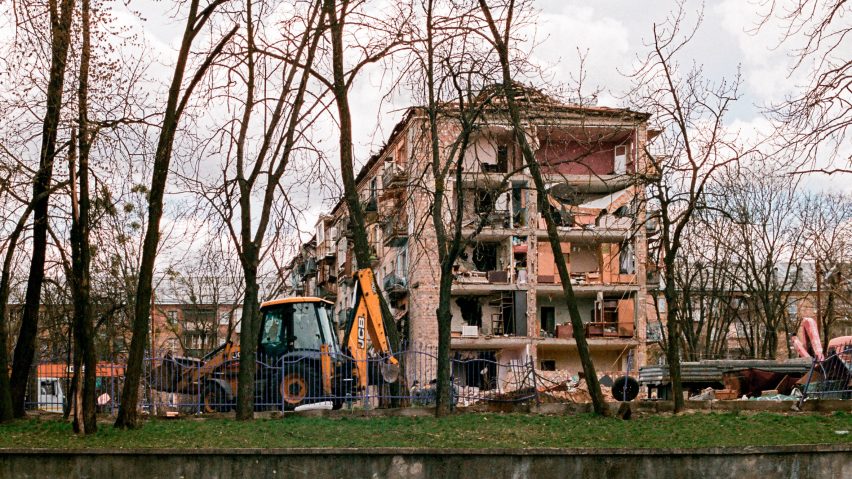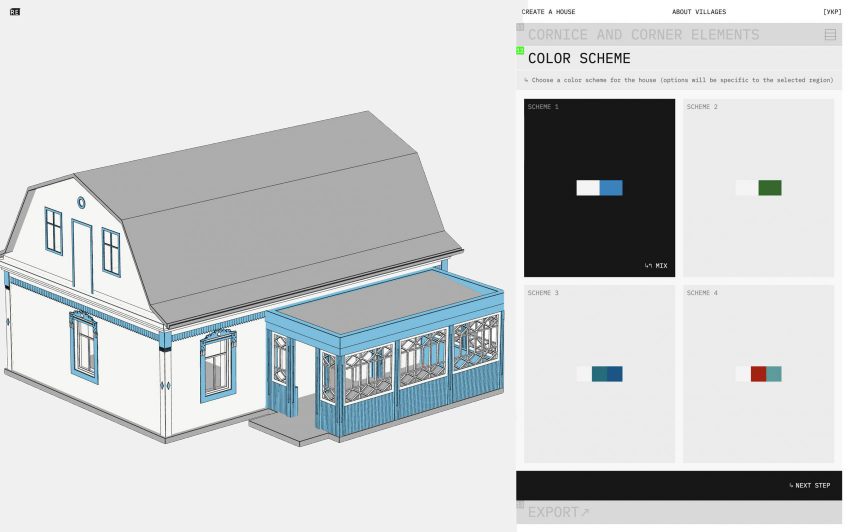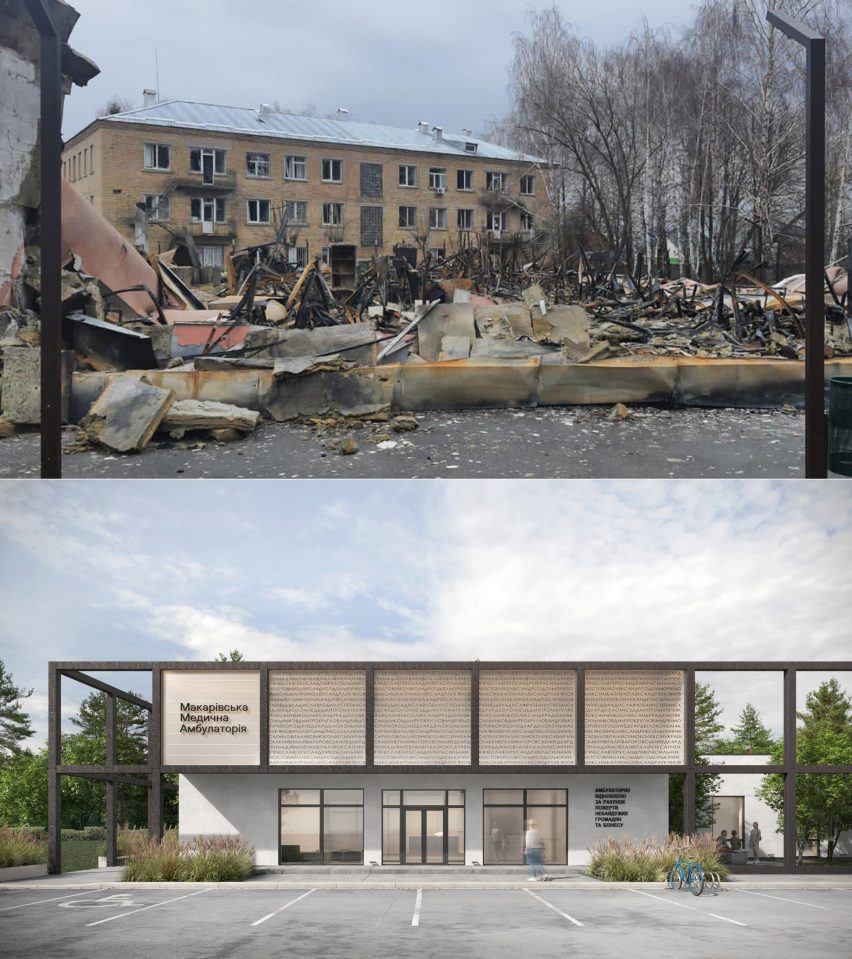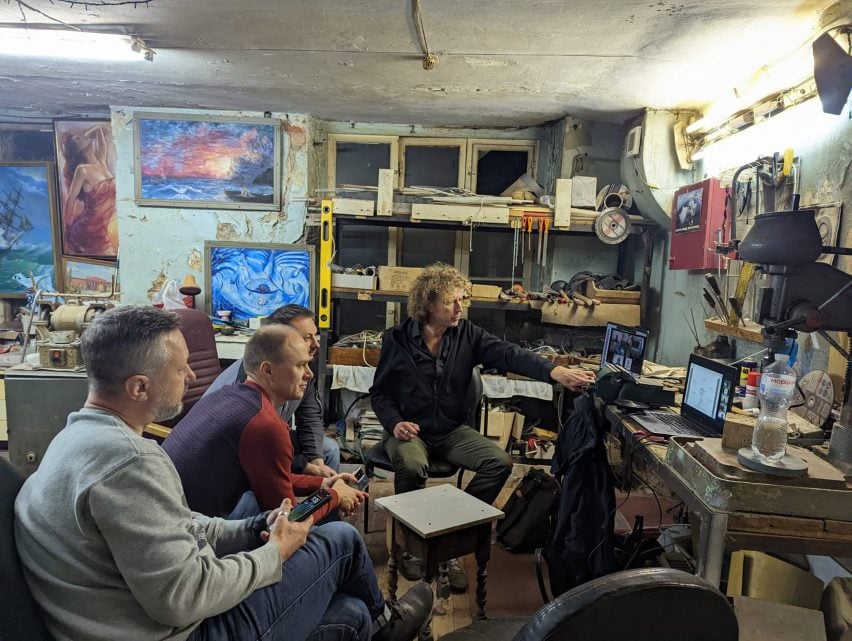
"Rebuilding under missiles is bold but we can't afford to wait" say Ukrainian architects
As the war in Ukraine enters its second year, Dezeen spoke to the architects and designers already working to rebuild their homeland.
In a demonstration of remarkable Ukrainian resilience, several rebuilding initiatives are taking place across the country despite continued Russian attacks on civilian areas.
"Life doesn't wait for anyone, and it will not wait for us," STEM charity founder Elizeveta Korenko told Dezeen. "We have to do this work now."
"We have to do this work now"
"Of course, rebuilding under missiles is a bold move, but we just can't afford to wait for the war to end," added Balbek Bureau founder Slava Balbek.
More than 19 million square metres of residential buildings have been destroyed in Ukraine since Russian troops crossed the border on 24 February 2022.
Some cities in recaptured areas have been largely reduced to rubble. In the commuter town of Bucha near Kyiv, where the Ukrainian government says Russian forces killed 458 people in a civilian massacre, Balbek Bureau is working on a housing project for 15 families.
The project, currently under construction, will act as a pilot for the studio's RE:Ukraine Housing concept, which it hopes can be used in disaster zones around the world.
Like many Ukrainian architecture studios, with most commercial projects on hold, some staff fighting on the front line and the rest spread across several time zones, Balbek Bureau has turned its attention to humanitarian initiatives.

It is also working on RE:Ukraine Villages, a digital design tool to aid the restoration of damaged rural homes, as well as an augmented reality app for visualizing restored streets and buildings.
"It may sound pretentious, but if you choose to stay in Ukraine and want your country to win, you pitch in and do your part," Balbek told Dezeen.
"Fellow foreign architects can, and hopefully will, contribute to these efforts, but it is we, those raised and based here, who know all the ins and outs and have a vision of what our country should look like when rebuilt," he added.
"Though we wish we never had to develop temporary housing for [internally displaced persons] or monument shelters, we are proud to be contributing to the shared effort to address war-inflicted issues."
"Negative emotions can become a moving energy"
"There are unbelievably terrible things on the frontline daily… but at the same time, there are a lot of people who need to work and live in the cities like Kyiv, Odesa, Lviv, where the situation is peaceful thanks to our forces," said Sivak + Partners co-owner Alexey Gulesha.
Sivak + Partners has designed 24 houses, currently under construction, at a former recreation camp in rural western Ukraine that has become a refuge centre for orphans.
"Negative emotions can become a moving energy for great deeds," added Gulesha. "To rebuild everything and create a better future for our country was the first thing to come after the shock we experienced in the first months of the war."
Individual rebuilding projects are currently focused on restoring essential amenities and infrastructure.
Kyiv-based Bogdanova Bureau, which had to repair its studio after it was damaged in a Russian missile attack in October, is rebuilding a hospital in Makariv, a town near Kyiv that suffered heavy civilian losses.
The hospital served 16,000 people until it was destroyed by a direct hit from a Russian missile during the early days of the invasion.
Bogdanova Bureau's reconstruction of the hospital, which is almost complete, will serve partly as a memorial to what happened in Makariv, with an exoskeleton of charred beams referencing the destroyed building.
"We aimed not only to resume the functionality of the building but also to manifest collective memory," explained studio founder and chief architect Olga Bogdanova.

"It is important to us not only to turn the page but to keep the memory of the difficult period of our history to realise the actual value of life," she added.
Similarly, Zikzak Architects has designed a modular school concept called Revival, that can be rapidly built and repurposed.
"It is important to get involved in reconstruction planning as soon as possible," said Zikzak CEO Alesia Karnaukhova. "The war continues, but so does life. We have to work and live, and for this we need schools, kindergartens, and hospitals."
Karnaukhova said Revival has "aroused considerable interest" and that the studio is currently seeking investors to replace the many destroyed schools across Ukraine.
Rejection of Soviet conventions
As well as these urgent responsive projects, Ukrainian architects are working on longer-term plans to rebuild entire cities.
For example, architect Victoria Yakusha is orchestrating a redevelopment plan for Chernihiv, an ancient city that was subjected to a brutal 39-day siege by Russia, leaving many buildings in ruins.
The rebuild will focus on involving the local community based on central themes of resilience and sustainability, rejecting the Soviet urban planning tropes that have shaped many Ukrainian cities.
"This is a unique approach for Ukrainian urban planning, which includes a rethinking of outdated approaches remaining from Soviet practice," Yakusha told Dezeen.
"Ukrainians have their own perception of the world and their own culture, traditions, which are the base," she added. "And it is important for us that our perception of the world and our mentality is reflected in our cities, because this is our identity."
"We don't want to lose it, because that's what we fight for."
Work started almost as soon as troops left the city, and despite Yakusha Studio having halved in size since the war broke out it is now coordinating a team of 60 volunteers on the project.
"It is the exact right time now, for sure, to think about concepts, strategies, development, all those things, which require time to understand and analyze," added Yakusha, whose home is in Bucha.
"We should ask ourselves who we are and what do we want and how to do this, in order that when the possibilities to rebuild arise and realization starts, we have not just answers to the questions above, but the action plan."
"Our hometowns have become cities of trauma"
Then there is Ro3kvit, a coalition of 80 experts in architecture, planning and other disciplines coordinated by Dutch architect Fulco Treffers.
"Our aim is to develop enough capacity in Ukraine to deal with all the huge building, planning and land-use questions that they have and more will come," Treffers told Dezeen.
"Usually countries start thinking about this when the war is over. At that moment, many problems are more complex, because of the lack of time to think, to learn, to discuss."
Ukrainian architect Oleg Drozdov, who is working on Ro3kvit, said rebuilt cities must be well-designed and human-centred if the country is to persuade the nine million Ukrainians currently living abroad to return home after the war.
"The biggest trauma of the war was not the built environment, but the fact that our hometowns have become cities of trauma, that certain destinies have been destroyed," he continued.
"Unfortunately, it will take us a long time to create the conditions to bring life back to the cities, and this is currently Ukraine's main challenge."

Despite these challenges, Korenko argues that rebuilding projects have an important morale-boosting function.
"We perfectly understand that war lasts a long time; it is a marathon," she told Dezeen. "But we need to believe that it will end, that someday it will be better."
"And talking about how people will live here after the war and what the country will be like after the war – it is about mental health and the need to give people hope during these difficult times."
Korenko is the founder and CEO of non-profit organisation STEM is FEM, which is running a programme to teach 50 Ukrainian girls about urbanism.
The teenagers will create their own reconstruction projects under the supervision of experts, with teachers including French architect Odile Decq. The best projects will have a chance to be realised.
Design brands demonstrate resilience
Design brands in Ukraine have also demonstrated extraordinary resilience over the past year.
Home fabrics manufacturer Shtayer saw its factory in the village of Slobozhanske destroyed by shelling and looting by Russian soldiers but rapidly built a new base in Kharkiv where a small sewing workshop had survived the Russian bombardment.
Part of the Shtayer team also left for western Ukraine with a handful of surviving sewing machines, starting a new clothing collection.
Similarly, furniture brand Tivoli has created a system for generating electricity from waste wood scraps – allowing it to keep running despite Russian attacks on Ukrainian power stations.
It is now setting up a second generator to supply energy to surrounding homes.
Asked for their reflections after a year of war, Ukrainian architects expressed profound sorrow but also unanimous optimism.
"This experience will never get out of our minds," said Gulesha. "We've seen a lot of disgusting and terrible things and struggled with obstacles we've never been ready to overcome."
"But through that time we've discovered a lot of good people and found out the better things inside ourselves which helped us to stay strong against aggression and continue to work despite everything," he continued. "We believe that good will conquer evil."
"Though we have accepted the new reality – as much as one can when living amidst a full-scale war – the pain and devastation it brings are still unbearable," echoed Balbek. "One can adapt to power outages, to missile attacks even, but never to losing the best of us."
"Ukraine will prevail – and our cities will be booming and blooming."
The top photo is by Maksym Pozniak-Haraburda.
Dezeen in Depth
If you enjoy reading Dezeen's interviews, opinions and features, subscribe to Dezeen In Depth. Sent on the last Friday of each month, this newsletter provides a single place to read about the design and architecture stories behind the headlines.